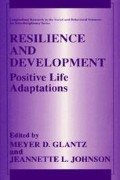Access this chapter
Tax calculation will be finalised at checkout
Purchases are for personal use only
Preview
Unable to display preview. Download preview PDF.
References
Anthony, E. J., & Cohler, B. J. (1987). The invulnerable child. New York: Guilford Press, pp. 147–184.
Bleuler, M. (1984). Different forms of childhood stress and patterns of adult psychiatric outcome. In N. S. Watt, E. J. Anthony, L. C. Wynne, & J. E. Rolf (Eds.): Children at risk for schizophrenia: A longitudinal perspective (pp. 537–542). New York: Cambridge University Press.
Block, J., Block, J., & Keyes, S. (1988). Longitudinally foretelling drug usage in adolescence: Early childhood personality and environmental precursors. Child Development, 59, 336–355.
Gore, S., & Eckenrode, J. (1992). Context and process in research on risk and resilience. Paper presented at the Conference on Risk, Resiliency, and Development: Research and Interventions. Kiawa Island, South Carolina, May 28–31.
Hoffman, L. W. (1991). The influence of family environment on personality: Accounting for sibling differences. Psychological Bulletin, 110, 187–203.
Kellam, S. G., Ensminger, M. E., & Simon, M. B. (1980). Mental health in first grade and teenage drug, alcohol, and cigarette use. Drug and Alcohol Dependence, 5, 273–304.
Magnusson, D. (1988). Individual development from an interactional perspective: A longitudinal study. Hillsdale, NJ: Erlbaum.
Masten, A. S., Best, K. M., & Garmezy, N. (1990). Resilience and development: Contributions from the study of children who overcome adversity. Developmental Psychopathology, 2, 425–444.
Nordberg, L. (1994). Ph. D. Dissertation, Karolinska Institutet, Department of Women and Child Health, Child and Adolescent Psychiatric Unit, Stockholm.
Parnas, J., Cannon, T. D., Jacobsen, B., Schulsinger, H., Schulsinger, F., & Mednick, S. A. (1993). Lifetime DSM-III-R diagnostic outcomes in the offspring of schizophrenic mothers: results from the Copenhagen high-risk study. Archives of General Psychiatry, 50, 707–714.
Rutter, M., & Smith, D. (1995). Psychosocial disorders in young people: Time trends and their causes. Chichester: Wiley.
Rydelius, P. A. (1981). Children of alcoholic fathers: Their social adjustment and their health status over 20 years. Acta Paediatrics Scandinavica. Supplement 286.
Scarr, S., & McCartney, K. (1983). How people make their own environment: A theory of genotype-environment effects. Child Development, 54, 424–435.
Shelder, J., & Block, J. (1990). Adolescent drug use and psychological health. American Psychologist, 45, 612–631.
Vaillant, G. (1983). The natural history of alcoholism. Cambridge: Harvard University Press.
Werner, E. E. (1986). Resilient offspring of alcoholics: A longitudinal study from birth to age 18. Journal of Studies on Alcohol, 47, 34–40.
Werner, E. E. (1990a). Protective factors and individual resilience. In S. Meisel and J. Shonkoff (Eds.), Handbook of Early Intervention (pp. 97–116). Cambridge: Cambridge University Press.
Werner, E. E. (1990b). Civil Society and Human Development. Law and Society Seminar, Harvard Law School, Cambridge, Mass, October 10.
Werner, E. E., (1991). The role of caring adults and religious coping efforts in the lives of children of alcoholics. Final Report to Lilly Endowment, Inc.
Werner, E. E. & Smith, R. S. (1982). Vulnerable but invincible: A longitudinal study of resilient children and youth. New York: McGraw Hill.
Werner, E. E., & Smith, R. S. (1993). Overcoming the Odds: High Risk Children from Birth to Adulthood. Ithaca, New York: Cornell University Press.
Wolin, S. J., & Wolin, S. (1993). The resilient self How survivors of troubled families rise above adversity. New York: Villard Books.
Author information
Authors and Affiliations
Editor information
Editors and Affiliations
Rights and permissions
Copyright information
© 2002 Kluwer Academic Publishers
About this chapter
Cite this chapter
Werner, E.E., Johnson, J.L. (2002). Can We Apply Resilience?. In: Glantz, M.D., Johnson, J.L. (eds) Resilience and Development. Longitudinal Research in the Social and Behavioral Sciences: An Interdisciplinary Series. Springer, Boston, MA. https://doi.org/10.1007/0-306-47167-1_13
Download citation
DOI: https://doi.org/10.1007/0-306-47167-1_13
Publisher Name: Springer, Boston, MA
Print ISBN: 978-0-306-46123-1
Online ISBN: 978-0-306-47167-4
eBook Packages: Springer Book Archive

